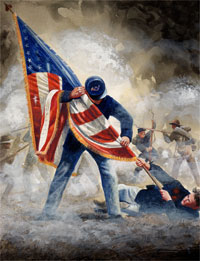The Red Badge of Courage

The Red Badge of Courage-full text
After reading the novel, answer the following questions using quotes whenever possible.
1. Compare and contrast Henry, Wilson, and Jim. What does each character seem to represent? How does Crane’s focus on the inner workings of Henry’s mind give the reader a picture of Henry different from that of any other character?
2. Analyze the effect of Crane’s frequent use of descriptive tags—such as “the youth,” “the tall soldier,” or “the loud one”—to refer to the characters, rather than the use of their actual names.
3. Thinking about Crane’s portrayal of the Civil War as a large historical phenomenon, how does Crane depict the different armies? What differences, if any, does he draw between them? What is his approach to the moral element of the struggle?
4. Consider Henry’s flashback to his conversation with his mother in Chapter I. What is his mother’s attitude about his enlisting in the first place? How does her advice foreshadow the main themes of the novel?
5. In the author’s point of view, is it wrong for Henry to run from the battle? Is it wrong for him to abandon the tattered soldier? More broadly, does The Red Badge of Courage have a moral center, or does it deny that moral categories such as “right” and “wrong” can exist in an indifferent universe?

